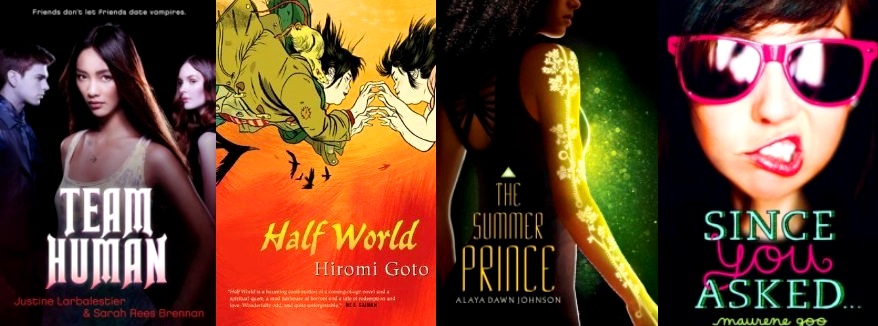So I took a YA lit class not so long ago — yes, this is a thing — and we had a book cover artist come in to talk to us about cover design. She went over some cool stuff — elements of cover design, the iconic imagery of the Hunger Games, etc. And then she pulled up a slide with fifteen YA book covers. They were sorted into three categories: Pretty Dead Girls, Sad Girls in Pretty Dresses, and Girls With Flowing Hair. She went on to beg us to never, ever create Pretty Dead Girl covers because those were so overdone.
In my head, I misremembered the whole thing and switched out Pretty Dead Girls with Dead White Girls. When I went home that day, I told my housemates about the funny book cover lady who lamented over the gazillions of Dead White Girl covers being put out every year. I wasn’t really wrong — there are an awful lot of tragic white girl covers gracing YA books. [Images via Goodreads]
First of all, what’s with the tragic/languishing/dead look? Kind of feels like passivity and vulnerability are considered the best way to showcase an attractive girl, eh? (Sexism rears its ugly head.) And don’t get me started on how every girl seems to have the same cookie-cutter good looks. Second, why is everyone white? If I judged YA lit by its book covers, I’d think that 90% of its books were identical stories about a sad girl languishing. This is simply unfair to YA lit as a whole. In recent years, attention has been drawn to the prevalence of these kind of covers and the issue of whitewashed covers.
At the same time, it’s not enough to simply point out that wow, there are a lot of tragic white girl covers and then hashtag it. Awareness may be the first step, but it’s not the last. After all, these book covers are nothing new. I like what Justine Larbalestier had to say on the problem of whitewashed book covers:
“I hope it gets every publishing house thinking about how incredibly important representation is and that they are in a position to break down these assumptions… I really hope that the outrage the US cover of Liar has generated will go a long way to bringing an end to white washing covers. Maybe even to publishing and promoting more writers of color. But never forget that publishers are in the business of making money. Consumers need to do what they can.”
Now let me change consumers to readers. (I tire of the implication by authors and publishers that ‘true activism’ is fueled primarily by buying power. Ugh, no.) Readers, a flexible role that bookworms, library patrons, editors and writers all take on, need to do what they can. We can recommend, review, buy, and promote beloved books that feature good cover design and diversity and quality writing — it’s not just about the covers, after all! As Cindy Pon puts it,
Whitewashing book covers is never okay, but it is easier to do when it is only happening to a few books—because the vast majority of other books feature no characters of color. It is something that, despite causing an uproar online in pockets of certain communities, can still be swept under the rug and soon be forgotten.
We see so many of the same YA covers because there is so little diversity within YA lit itself. The covers are only the symptom of a greater problem. Readers need to do what they can. To back up my words, here are some awesome books and their lovely covers:
Team Human by Justine Larbalestier and Sarah Rees Brennan
Half World by Hiromi Goto
The Summer Prince by Alaya Dawn Johnson
Since You Asked by Maurene Goo
Ambelin Kwaymullina, author of The Interrogation of Ashala Wolf, concludes her article (definitely go read the whole thing!) on the disappearance of race from YA lit by saying,
“So, to all the teenagers out there, whoever you are and from wherever you come, I say this – you deserve all the stories: the ones about people like you, and the ones about people unlike you… You deserve stories that make your existence larger, not smaller; stories that expand rather than limit your reality. And when you walk into a bookstore, you deserve to be surrounded by a crowd of faces, of all colours and cultures and races, and to know that behind every one of those faces is a new world waiting to be discovered…and all it takes to experience it is the turn of a page.”
For more reading: Another great resource discussing YA book cover trends (and problems!), complete with lots of pie charts: Uncovering YA Covers: 2011 by Kate Hart




Well said! I plan to dive right into the books you listed above (the ones I missed anyway; I read and loved Team Human).
Perfect essay Jessica! I spent a good chunk of my Master’s thesis and lecture talking about the issue w/covers. I did a ton of research, but this blog post by Kate Hart is all the things. http://www.katehart.net/2012/05/uncovering-ya-covers-2011.html
Ohhhh! Thanks for the link! It looks amazing. I’m going to throw it into my post.